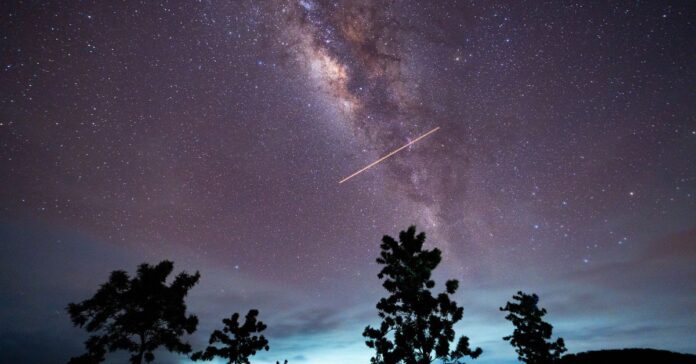If you’ve got clear skies and want an excuse to get away from town, the Eta Aquarid meteor shower is roughly at its peak and should be going strong tonight. Made up of remnants of Halley’s Comet that the Earth passes through, this annual shower is active from April 15th to May 27th and can show up at a rate of about 10–30 meteors per hour, according to the American Meteor Society.
You can see the Aquarids starting around 2AM local time in the Northern Hemisphere, radiating from the Aquarius constellation (though you’ll want to look 40–60 degrees around Aquarius to see them). Weather permitting, conditions are pretty good for watching them since the moon is in its late waning period and won’t be reflecting much light. Try to plan your stargazing spot using a light pollution map or by checking with your local astronomical society for tips on the best places to go for unfettered viewing.
As NASA writes, Eta Aquarid is viewable as “Earthgrazers,” or “long meteors that appear to skim the surface of the Earth at the horizon.” They’re fast-moving, traveling at over 40 miles per second.
You can bring binoculars or a telescope if you want to look at the stars, too, but you can see meteors with your naked eye, and trying to look for them with binoculars limits your field of view too much to be practical. Be sure to go easy on your neck with a reclining chair or something to lay on, too; heavy is the head that watches the stars. And dress appropriately, since it’s often chillier out in the country than in the city at night.
Finally, be patient. It can take around 30 minutes for your eyes to adjust to the dark enough to see meteors. Once they do, assuming you’re in a dark enough place, you should be able to see not just the meteors, but plenty of stars and even satellites as they move across the sky.
Halley’s Comet comes around, inconveniently for most, only once every 76 years. The last time it showed its tail for Earth-dwellers was in 1986, when I was three years old, and it won’t be here again until 2061, when I’m 78 (if I’m even still alive). Very rude. But at least we get to see some of the junk it leaves behind.
Credit: Source link

















